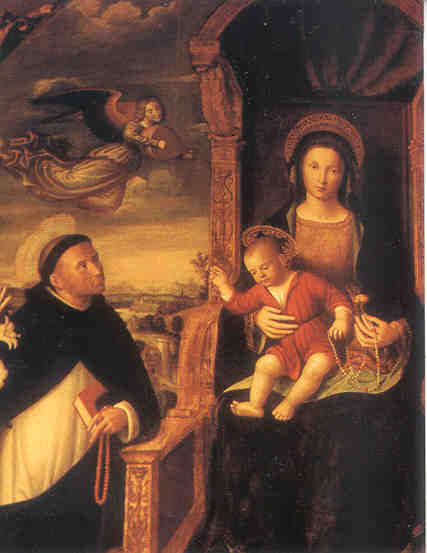Scared of the two archangels who show Him the instruments of His passion, Jesus has run to His Mother, almost loosing one of his sandals on his run. Mary holds Him on her arms in a protective and loving way. Yet, Mary's sight is not on her son, Jesus, but on ourselves.
The tiny hands of Jesus are holding Mary's hands to remind us that just as He used to hold the hands of Her Mother seeking her protection and help, He entrusts into her hands our own protection and help.
This is the general message of this icon, but it is full of symbols that we should understand. It is important to consider that the shape and size of hands and eyes are always important to understand the meaning of an icon.
1. Greek initials for "Mother of God".
2. The crown. It was added to the original icon by prescription of the Holy See in 1867. This is a tribute to Mary for the many favors she has granted to her children when invoked as "Mother of Perpetual Help".
3. The star on the veil. Mary is known as the Stella Matutina, the morning star that brought the light in the midst of darkness. As the morning star guides sailors to their port, Mary guides us to the port of salvation.
4. Initial in Greek for Michael the Archangel, who holds the spear and the sponge used in the Passion.
5. Initial in Greek for Gabriel the Archangel, who holds the cross and nails.
6. Mary's mouth is very small on its size, to symbolize her silent recollection.
7. Mary's eyes on the contrary are big, to see our problems and preoccupations. Mary's eyes are looking at us on this icon.
8. Red tunic, a garment proper of the virgins in the times of Christ.
9. Greek initials for Jesus Christ.
10. Jesus' hands, with their palms facing down and inside Jesus' Mother's hand, symbolize that the graces of redemption are kept in custody in the hands of Mary.
11. The yellow background is the symbol of Heaven, where Jesus and Mary have been crowned. This yellow is also reflected on the garments of Jesus and Mary, symbolizing the celestial joy they bring to our hearts.
12. The dark blue tunic of Mary was the garment used by mothers in Palestine. Mary was at the same time a mother and a virgin.
13. Mary's left hand supporting Christ possessively. She is her mother. It is a comforting hand for everyone who calls on her
14. The dangling sandal. Did Jesus loose it on His run seeking for the protection and help of Her mother after seeing the vision of His passion from the archangels?
************************************************************************************************




